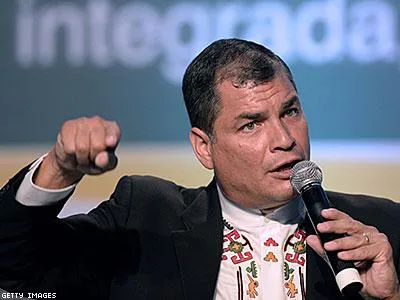Is Ecuador really going electric? Government program to eliminate gas subsidy and convert to more electric usage is far behind schedule
By Sylvan Hardy
Although the plan to transition Ecuadorian households from LP gas to more electric usage was announced with great fanfare in August 2013, the government has had little to say about it in recent months. 
The program was coupled with the announcement that the subsidy of LP gas would end in late 2016, although later statements suggested that it would continue until early 2017. Under the subsidy, residential consumers pay 15% to 20% of the international market rate for gas.
In exchange for ending the subsidy, the government offered low interest loans for the purchase of electric induction cook tops and said it would lower electric charges on the first 60 kilowatts of household electric usage per month.
The government admits that the number of households converting to electric cook tops fell more than 80% short of expectations in 2014. In December, the shortfall prompted a 100% tax surcharge on gas ranges in hopes of spurring sales of electric units. The tax effectively ended the manufacture of gas ranges for the Ecuadorian market but, ironically, has not led to greater sales of electric cook tops in the first three months of 2015.
Some political analysts and power industry officials say that the electrification plan was not well thought through when it was announced, and could take years to reach its objectives. The problem, they say, is that electrification on the scale the government envisions will require major upgrades to the national power grid as well as large outlays by individual Ecuadorians to convert electric service from 110v to 220v to accommodate electric appliances, including cook tops.
“On the national level, we will need to install new wiring and transformers, and will need to upgrade equipment in electric sub-stations,” says Fernando Salinas, director of the Pichincha College of Electrical Engineers. “This could cost a $100 million or more.”
“For individual households, it could cost hundreds of dollars to make the change to 220v service,” he says, adding, “And it will be very difficult to do at all in many older houses and buildings,” he said.
Salinas says the bigger problem is that most Ecuadorians have not bought in to the electrification plan. “They’re confused and are reluctant to give up a system that has worked well for them. Many people are waiting to see what happens before they spend money on new stoves,” he said.
The cornerstone of the government’s plan, the construction of eight hydroelectric generation projects, appears to be progressing well, although months behind schedule. In December, the first of the projects went online on the border of Imbabura and Pichincha Provinces. The Manduriacu hydroelectric dam and generation plant can produce up to 165 megawatts of power. Two weeks ago, the country’s largest electric project, the Coca Coda Sinclair hydroelectric project, east of Quito, celebrated the completion of a 24-kilometer water transfer tunnel. Coca Coda Sinclair will generate 1500 megawatts. Construction of all eight of the hydro plants, including two near Cuenca, is being managed by Chinese companies.
The government claims, and industry officials agree, that once all eight projects are operational in 2016 or 2017, Ecuador will be electric-energy self-sufficient and will produce a surplus that can be sold to Colombia and Peru.
When President Rafael Correa announced the program in 2013, he said the end of the gas subsidy would reduce pollution, improve household safety and save the country $700 million to $800 million annually, enough to build and reconstruct 1,000 schools a year. He also argued that the subsidy has been misused. “It was not intended to heat the swimming pools of rich people in Cuenca and Quito. The subsidy was meant to help poor people cook their meals,” he said.
Following Correa’s announcement, in which he seemed to advocate household electrification in general, the energy ministry issued a clarification that the government’s first priority was the conversion to electric induction cook tops and not necessarily to other electric appliances, such as hot water heaters and electric washers and dryers.
Another factor complicating the program, and one that has received little attention, is politics. If the government sticks to its plan to eliminate gas subsidies, despite slow electrification progress, it could hurt Correa’s chances for reelection in the 2017, assuming the constitution is amended to allow him to run again, and assuming that we will in fact run, both considered likely.
In 2007, during his first presidential term, Correa joked that he would be “lynched” if he ended the gas subsidy. More than most people, he understands that the availability of subsidized gas is critically important to much of the population, especially the poor.
As the government considers its electrification strategy and the elimination of the gas subsidy in the coming months, it’s reasonable to expect that Correa will be looking over his shoulder, keeping an eye out for the lynch mob.






















